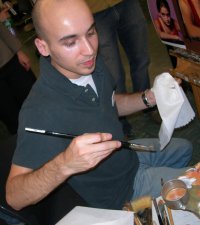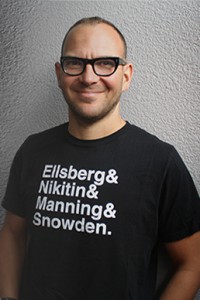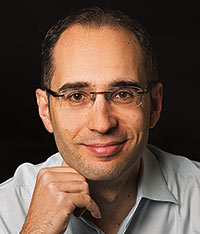Spotlight on Daniel Dos Santos, Artist
Daniel Dos Santos began drawing as a chi ld, studied art through an internship program during high school, and attended the School of Visual Arts from 1996-2000, graduating with a BFA in illustration. He’s done covers for many SF publishers, plus artwork for Disney, Universal Studios, The Greenwich Workshop, and Dark Horse Comics, among others. He won Chesley awards from the Association of Science Fiction & Fantasy Artists in 2007 and 2009, and is currently a Hugo finalist in the Best Professional Artist category.
Website: The Art of Dan Dos Santos
How did you get your start as a science fiction illustrator? What artists most influenced you?
As a child, my greatest influences were comic books and cartoons. Thundercats, Transformers, and the X-Men were massive passions of mine. I spent a lot of time drawing these characters, usually mimicking my favorite artists of the time, such as Jim Lee and Todd McFarlane. I loved their work, but was always seeking out depictions that were more ‘‘realistic.’’ Eventually I stumbled across the work of artists like Joe Jusko and Julie Bell in my local comic shop, both of whom had painted trading card sets of Marvel characters. This opened my eyes to the world of painting, which seemed far more capable of rendering realistic depictions of the superheroes I loved so much. That interest in painted images eventually led me to artists like Luis Royo and Michael Whelan, and consequently the entire SF/F genre.
Once I graduated high school, I was pretty determined to be a SF/F Illustrator, and so I went to college to pursue that dream. The rest is history.
What’s more important – inspiration or perspiration? Is being an artist a higher calling, or a craft like any other?
Definitely perspiration. If I had to wait around for inspiration to strike, I would never get any work done.
As a professional illustrator, you need to be capable of working diligently on a piece whether or not it is particularly inspiring. Oddly, once you start to do that, you begin to find those sparks of inspiration hidden within the monotony of the work, like they were nuggets of gold that just needed to be sifted out through hard work.
Being an ‘‘artist’’ can be a higher calling, since for many it is inexplicable desire that borders on compulsion. But commercial illustration is a bit different, you don’t always get to paint exactly what you want to. It a balancing act between passion and practicality. I truly believe illustrators are the world’s ‘‘Blue-collar Artists.’’
Why the focus on science fiction/fantasy?
SF/F appeals to me for both personal and practical reasons. On a personal level, I was inspired at a young age by comics, cartoons and film. The SF/F genre just seemed like a natural progression of those interests. On a more practical note, the SF/F genre is one of the few markets that still uses painted illustrations. I’m sure that a lot publishers would use a photo of a dragon if they could get one, but they can’t. So until then, the market remains a fairly healthy venue for traditional artists whose imaginations can help bring these other-worldly covers to life.
Is there one work you’d particularly like our readers to see, either because it’s most representative, or because you’re especially proud of it?
For the most part, I hate everything I paint about 4 months after I paint it. Though I have one painting that after 3 years I still really enjoy: ‘‘Butcher Bird’’ is my personal favorite: <www.dandossantos.com/ gallery/illustrations/full_butcher_bird.jpg>. I believe that a good piece of art is easier to create than a good illustration. A painting has only to look beautiful; but a commercial illustration has to work well with type, be attractive to the consumer, and still accurately depict the story. I think ‘‘Butcher Bird’’ is the closest I’ve come to satisfying all those criteria.
Can you tell us a little about Art Out Loud?
Art Out Loud is a series of live art demos that my friend Irene Gallo and I host at the Society of Illustrators. Originally, it started out as a collaborative painting demo, where six artists all swapped work back and forth creating about 20 paintings over the course of four hours. It was really fun to watch, but we felt it was not an accurate depiction of the way those artists actually worked in their studio. Interest in the demos grew quickly, especially amongst students, and so we eventually began to hone the events to be a more practical demonstration of the individual artists’ techniques. Now, we have anywhere from two to six artists working simultaneously (but separately) in one large room. The attendees get to walk around for four hours and ask questions of all the artists as they watch over their shoulder. In the spirit of education, we have strived to keep the ticket prices incredibly low (usually about $20), and all the profits go to funding further ‘Art Out Loud’ events. For information on any upcoming demos, just check in periodically at my website, Irene’s blog, or the Society of Illustrators’ website.
Is there anything else you’d like our readers to know about you or your work?
For those that are interested in learning more about what goes into the making of a book cover, please be sure to check out my website www.dandossantos.com, where I have several free tutorials that cover the whole process.










Pingback:Tweets that mention Locus Online Perspectives » Spotlight on Daniel Dos Santos, Artist -- Topsy.com
Pingback:Byrt’s weekly blog ramble (10/29)
Pingback:Artist Spotlight: Taking Flight with Dan dos Santos – Grumpy's Geek Sanctum